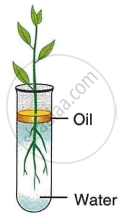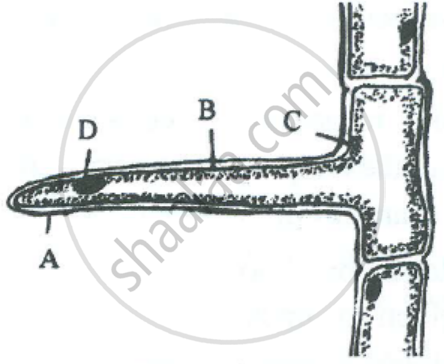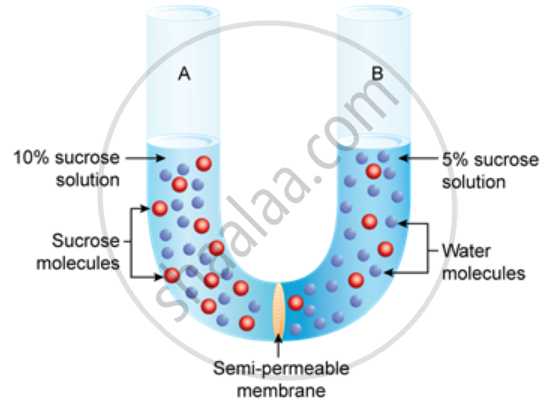Advertisements
Advertisements
Question
The below figure shows a root hair:
(i) Label the parts 1 to 4.
(ii) What is the role of part 4?
(iii) Why is the root hair one-celled?
(iv) What will happen to the root hair if some fertilizer is added to the soil near the root hair?
Solution
(i) 1. Nucleus
2. Vacuole
3. Cell wall
4. Cell membrane
(ii) Part 4 is the cell membrane. It is semi-permeable. It allows only water molecules to pass through it.
(iii) Because it is an extension of epiblema cell.
(iv) By the addition of fertilizer, root hair becomes flaccid, because water will move out of it as soil water becomes hypertonic.
APPEARS IN
RELATED QUESTIONS
The diagram of an given below demonstrates a particular process in plants. Study the same and answer the questions that follow :

(i) Name the apparatus.
(ii) Which phenomenon is demonstrated by this apparatus?
(iii) Explain the phenomenon mentioned in (ii) above.
(iv) State two limitations of using this apparatus.
(v) What is the importance of the air bubble in the experiment?
(vi) Name the structures in a plant through which the above process takes place.
Multiple Choice Question:
Put a tick mark (✓) against the correct alternative in the following statement:
The root-hairs are suited for absorbing water from the soil because:
Study the diagram given below and answer the questions that follow:

- Name the process being studied in the above experiment.
- Explain the process mentioned in (a) above
- Why is oil placed over water?
- What do we observe with regard to the level of water when this set-up is placed in (1) bright sunlight, (2) humid conditions and (3) windy days?
- Mention any three adaptations found in plants to foster the process mentioned in (a) above
The diagram given below represents the results of an experiment conducted on two freshly taken leafy shoots of a herbaceous plant. The lower ends of the shoots dip in ordinary water.
(i) What is the aim of the experiment?
(ii) Some parts of the stem in both the shoots have been removed. Name the conducting tissue in shoot (a) and in shoot (b) that has been removed.
(iii) What are the results of this experiment?

The diagram below represents a layer of epidermal cells showing a fully grown root hair. Study the diagram and answer the questions that follow:

Mention one distinct difference between the parts labelled A and B.
Study the experimental setup in the figure and then answer the question that follow.

Explain the phenomenon mention in question 8.1 .
A thin strip of epidermal cells of a leaf was observed in a drop of water. They all looked turgid and normal.
(a) Draw a diagram of such a cell.
(b) Draw a diagram of a cell if this strip is transferred to a strong concentrated solution of sugar. What is term used for the effect on the cells ?
Most plant cells and tissues constitutes _____ % water.
Root hairs are ______
Identify the zone in wbkh root hair occurs.
